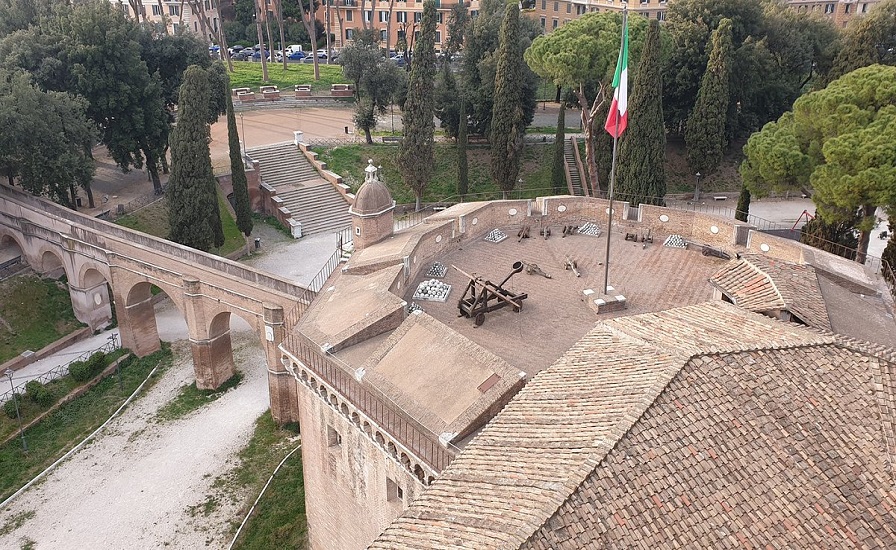Passetto Di Borgo

Introduction
Did You Know that in the Vatican there is a Secret Medieval Passageway? The Passetto di Borgo is a secret pedestrian passageway linking the papal residence in the Vatican to Castel Sant’Angelo. It is 800 metres long and was created to facilitate a swift escape to Castel Sant’Angelo in case of danger. Three quarters of […]
Tools
Supplies
Did You Know that in the Vatican there is a Secret Medieval Passageway?
The Passetto di Borgo is a secret pedestrian passageway linking the papal residence in the Vatican to Castel Sant’Angelo. It is 800 metres long and was created to facilitate a swift escape to Castel Sant’Angelo in case of danger. Three quarters of the passageway are owned by the Italian state, and the remaining part inside the Vatican is closed to the public.
The Saracens and the Leonine Walls
In 852, after the Saracen attacks that had plundered St. Peter’s Basilica, Pope Leo IV had the Vatican surrounded with walls, around six metres high, made up of blocks of tufo stone and bricks that had been ‘recycled’ from Roman buildings, with 44 watchtowers and 3 gates, creating the so-called “Leonine City”.
The Passetto
The Passetto was created in the walkway of the walls, possibly by Pope Nicholas III Orsini (in around 1280), whose family owned Castel Sant’Angelo, and who transferred the papal seat from the Lateran to the Vatican, so as to have a fortress that would be of exclusive use to the Pope since 1300.
In the 15th century a crenelated walkway was created on the Passetto. Pope Pope Alexander VI restructured it and used it to take refuge during the invasion of Charles VIII of France in 1494.

The Sack of Rome: When the Pope Fled to his Safety along the Passetto
Emperor Charles V attacked Rome on the 6th of May 1527, (against the anti-Habsburg League), and in his troops there were also the German Landsknechts (protestants and anti-Pope supporters).
Pope Clement VII was saved when courtiers and noblemen covered him in a dark cloak to prevent his white robe from becoming a moving target, as the Swiss Guards, who protected his retreat, were slaughtered. Still today, evidence of the brutal assault with harquebuses, or ‘hook guns’, can be seen in the walls.
The Modern Openings in the Passetto: from Human to Four-Wheeled Traffic
In the 16th century the Borgo district was home to hospital, churches, monasteries, shops, taverns and hostels, and it began to expand beyond the Leonine Walls, so it was necessary to create arches in the Passetto. Many were ‘signed’ by Pope Pius IX Medici with his coat of arms (6 spheres, apparently representing medicinal pills, a play on words regarding his surname Medici – Medics – or oranges, alluding to commerce with the East). For this reason one of the Streets in the Borgo district is called Via delle Palline – The Street of the Small Balls. Admire the Passetto starting out facing Saint Peter’s Basilica, turning right towards the northern colonnade, and reaching Porta San Pellegrino. Continue along Largo del Colonnato where you will come across Porta Angelica with two arches. On the side towards Piazza Risorgimento, the arch on the right has the Medici coat of arms and even higher up the bees from the coat of arms of Pope Urban VIII Barberini, who performed the restoration.
The arch on the right was opened by the Council of Rome in 1933 (the crest SPQR) , and if you look closely you can see the letters “E.F.”, Era Fascista, – Fascist Era – one of the traces lefts by the Fascist regime on many buildings (most of these symbols were destroyed after the Second World War).
Go along Via dei Corridori, which runs parallel to the Passetto and cross Piazza Pia where there is a plaque in memory of partisans killed by the Nazis in 1944, and finally the walls join those of Castel Sant’Angelo.
Can the Inside of the Passetto be Visited?
The Passetto can be visited from the Castel Sant’Angelo National Museum. It is open to the public with guided tours; currently it is being restored, so we suggest you to admire it from above, either by climbing up to the dome of Saint Peter’s or the terrace of Castel Sant’Angelo.